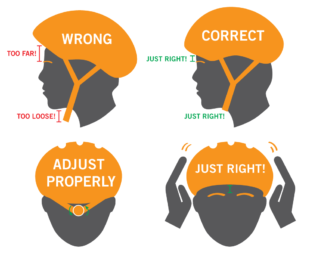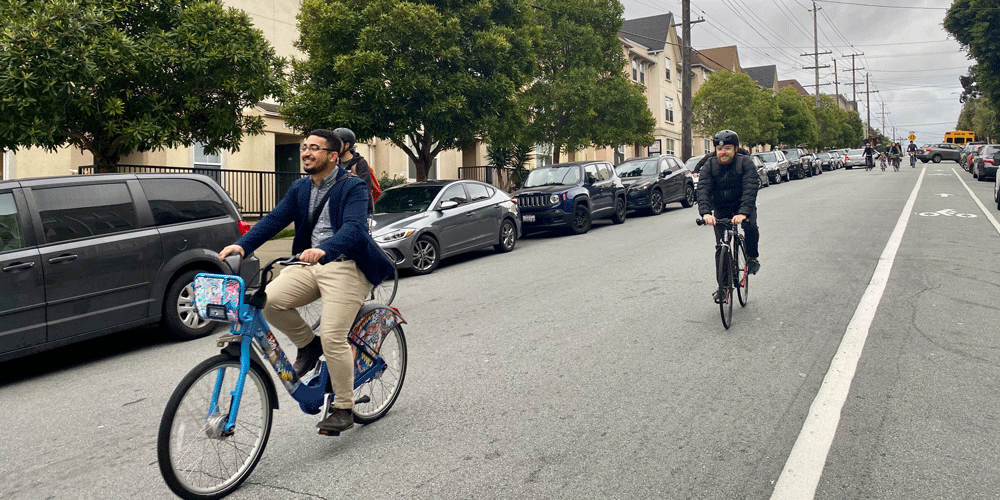Note: the shelter-in-place public health order limits travel, no matter the mode, to essential trips.
The question of how to move around San Francisco safely is one we’ve been asking ourselves since the shelter-in-place order was established. San Franciscans rely on public transportation to access essential services, and with service cuts being made to both BART and Muni, we’re having to adjust how we get from point to A to point B.
My name is Eliana and I run our Adult Bicycle Education Program here at the SF Bicycle Coalition. Biking remains an affordable, sustainable, and fun transportation option, and is a great way to get around during this pandemic (and beyond)! I taught an Intro to Urban Biking Webinar this past Tuesday (check out more of our free online classes here) and got to engage with many people who are beginning to ride for the first time or thinking about riding their bikes after a hiatus.
Whether you are using bikeshare, borrowing a bike, or using your own, here are five things you should know before hitting the road. I hope you find this list helpful — and be sure to practice social distancing while biking and wash your hands for at least 20 seconds once you’re home!
1. Complete your ABC Quick Check before riding.

- Do this one minute pre-ride check every time you ride to ensure that your bike is ride-ready:
- A = Air. Squeeze your tires. They should feel hard, like a potato. If they need air, you can find the recommended PSI (pounds per square inch) on the sidewall of your tire. If you have a pump with a gauge, pump up your tire to within the recommended range. If you don’t, no worries, just fill them up until they are potato-hard. If it’s been a while since you rode, your tires may be brittle and have cracks. If this is the case, they should be replaced.
- B = Brakes. The easiest way to check your brakes is to squeeze down on each brake one at a time (Right = Rear, Left = Front) and try to roll your bike forward. If there is significant forward movement, your brakes should be adjusted. If you don’t feel confident that your brakes are working well, take your bike to a bike shop before riding it!
- C = Chain and Cranks. Check your chain for any visible rust, and clean and lube if needed. The cranks connect your pedals to the bike frame. Pull them away from the frame; if they move, they should be tightened.
- Quick = Quick Releases. Most bikes have quick release levers on the wheels and seat. Make sure these are tight, the levers are locked and curving toward the frame. The levers on your wheels should be pointing towards the rear of your bike (not pointing forward, as they could get caught on something).
- Check = Final check. Finally, shake your bike, bounce your bike, and make sure nothing falls off or sounds weird. Ride around the block before heading out on your ride to make sure everything is in working order.
2. Ensure proper helmet fit.

- You should replace your helmet every three years, or after any significant impact – whether a crash or dropping it down the stairs.
- If you have a knob on the back of your helmet, loosen the knob and place the helmet on your head. Then tighten it as much as is comfortable. Once your helmet is tightened on your head, there are three things you want to check:
- Eyes: When you look up (only moving your eyes, not your head) you should be able to see the rim of your helmet. If you can’t, lower the front of your helmet until you can see the rim.
- Ears: Most helmets have adjustable Y straps. If you can adjust the Y straps, make sure the fork of the Y is at your ear lobes.
- Chin: Adjust your chin strap so that you can’t fit more than two fingers (stacked one on top of the other) between your chin and the chin strap.
3. Avoid the door zone
- Whether riding in a bike lane or on a shared street, you should always be sure to stay 3-5 feet away from parked cars to avoid any opening doors. Some standard bike lanes are not painted outside of the door zone, so ride on the left side of the lane to be outside of the door zone. If you are opening a car door, remember to check for people biking before opening your door.
4. Practice social distancing in our bike lanes and on our streets.
- Scan, signal, and scan again before leaving the bike lane to pass someone with six feet of clearance.
5. Biking is great for the whole family! If under 13, children are allowed to bike on the sidewalk.
- Their parents should still be biking on the street.
- Remember to remind children to still stay 6 feet away from others.
For more resources on biking confidently in the city, check out all of our virtual classes.


